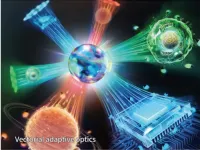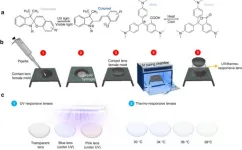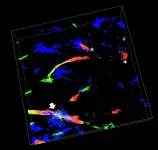(Press-News.org) Image
A new kind of "wire" for moving excitons, developed at the University of Michigan, could help enable a new class of devices, perhaps including room temperature quantum computers.
What's more, the team observed a dramatic violation of Einstein's relation, used to describe how particles spread out in space, and leveraged it to move excitons in much smaller packages than previously possible.
"Nature uses excitons in photosynthesis. We use excitons in OLED displays and some LEDs and solar cells," said Parag Deotare, co-corresponding author of the study in ACS Nano supervising the experimental work, and an associate professor of electrical and computer engineering. "The ability to move excitons where we want will help us improve the efficiency of devices that already use excitons and expand excitonics into computing."
An exciton can be thought of as a particle (hence quasiparticle), but it's really an electron linked with a positively-charged empty space in the lattice of the material (a "hole"). Because an exciton has no net electrical charge, moving excitons are not affected by parasitic capacitances, an electrical interaction between neighboring components in a device that causes energy losses. Excitons are also easy to convert to and from light, so they open the way for extremely fast and efficient computers that use a combination of optics and excitonics, rather than electronics.
This combination could help enable room temperature quantum computing, said Mackillo Kira, co-corresponding author of the study supervising the theory, and a professor of electrical and computer engineering. Excitons can encode quantum information, and they can hang onto it longer than electrons can inside a semiconductor. But that time is still measured in picoseconds (10-12 seconds) at best, so Kira and others are figuring out how to use femtosecond laser pulses (10-15 seconds) to process information.
"Full quantum-information applications remain challenging because degradation of quantum information is too fast for ordinary electronics," he said. "We are currently exploring lightwave electronics as a means to supercharge excitonics with extremely fast processing capabilities."
However, the lack of net charge also makes excitons very difficult to move. Previously, Deotare had led a study that pushed excitons through semiconductors with acoustic waves. Now, a pyramid structure enables more precise transport for smaller numbers of excitons, confined to one dimension like a wire.
It works like this:
The team used a laser to create a cloud of excitons at a corner of the pyramid's base, bouncing electrons out of the valence band of a semiconductor into the conduction band—but the negatively charged electrons are still attracted to the positively charged holes left behind in the valence band. The semiconductor is a single layer of tungsten diselenide semiconductor, just three atoms thick, draped over the pyramid like a stretchy cloth. And the stretch in the semiconductor changes the energy landscape that the excitons experience.
It seems counterintuitive that the excitons should ride up the pyramid's edge and settle at the peak when we imagine an energy landscape chiefly governed by gravity. But instead, the landscape is governed by how far apart the valence and conduction bands of the semiconductor are. The energy gap between the two, also known as the semiconductor's band gap, shrinks where the semiconductor is stretched. The excitons migrate to the lowest energy state, funneled onto the pyramid's edge where they then rise to its peak.
Usually, an equation penned by Einstein is good at describing how a bunch of particles diffuses outward and drifts. However, the semiconductor was imperfect, and those defects acted as traps that would nab some of the excitons as they tried to drift by. Because the defects at the trailing side of the exciton cloud were filled in, that side of the distribution diffused outward as predicted. The leading edge, however, did not extend so far. Einstein's relation was off by more than a factor of 10.
"We're not saying Einstein was wrong, but we have shown that in complicated cases like this, we shouldn't be using his relation to predict the mobility of excitons from the diffusion," said Matthias Florian, co-first-author of the study and a research investigator in electrical and computer engineering, working under Kira.
To directly measure both, the team needed to detect single photons, emitted when the bound electrons and holes spontaneously recombined. Using time-of-flight measurements, they also figured out where the photons came from precisely enough to measure the distribution of excitons within the cloud.
The study was supported by the Army Research Office (award no. W911NF2110207) and the Air Force Office of Scientific Research (award no. FA995-22-1-0530).
The pyramid structure was built in the Lurie Nanofabrication Facility.
The team has applied for patent protection with the assistance of U-M Innovation Partnerships and is seeking partners to bring the technology to market.
Study: Enhanced Exciton-Drift Transport through Suppressed Diffusion in One-Dimensional Guides (DOI: 10.1021/acsnano.3c04870)
END
Nextgen computing: Hard-to-move quasiparticles glide up pyramid edges
Computing with a combination of light and chargeless excitons could beat heat losses and more, but excitons need new modes of transport
2023-11-28
ELSE PRESS RELEASES FROM THIS DATE:
Unlocking the secrets of cells with AI
2023-11-28
Machine learning is now helping researchers analyze the makeup of unfamiliar cells, which could lead to more personalized medicine in the treatment of cancer and other serious diseases.
Researchers at the University of Waterloo developed GraphNovo, a new program that provides a more accurate understanding of the peptide sequences in cells. Peptides are chains of amino acids within cells and are building blocks as important and unique as DNA or RNA.
In a healthy person, the immune system can correctly identify the peptides of irregular or foreign cells, such as cancer cells or harmful bacteria, and then target those cells for destruction. For people whose immune system is ...
Vectorial adaptive optics: correcting both polarization and phase
2023-11-28
Adaptive optics (AO) is a technique used for real-time correction of phase aberrations by employing feedback to adjust the optical system. Polarization aberrations represent another significant type of distortion that can impact optical systems. Various factors, such as stressed optical elements, Fresnel effects, and polarizing effects in materials or biological tissues, can induce polarization aberrations. These aberrations affect both system resolution and the accuracy of vector information.
Vectorial aberrations result from the ...
Contact lenses developed by Khalifa University team respond to UV and temperature changes
2023-11-28
The global rise in ocular diseases, largely due to insufficient ophthalmic diagnostics and monitoring, has emphasized the need for better treatment methods. Pioneering developments in therapeutic and diagnostic contact lenses are now offering hope in treating these diseases.
Cataracts, which cloud the lens of the eye, are a prime example, affecting 94 million people and leading to 10 million surgeries annually. A significant factor in the rise of cataracts and other ocular conditions, such as age-related macular degeneration (AMD) and photokeratitis, is excessive exposure to ultraviolet (UV) light.
In response, a team of researchers at Khalifa University has ...
Gaining more control over the fabrication of surface micro/nano structures using ultrafast lasers
2023-11-28
Surface functionalization via micro/nano structuring is not only a thriving research area inspired by bionics but also of great importance for various practical applications. The key to achieving various surface functions is the fabrication of surface micro/nano structures with controlled dimensions, hierarchies, and compositions, which is driving the continuous progress of micro/nano fabrication techniques. Researchers from the Laser Materials Processing Research Center at the School of Materials Science and Engineering of Tsinghua University, China, have spent years in developing laser-enabled fabrication ...
Call for papers
2023-11-28
1 Overview
A number of open source resources, in the form of curated datasets, web-based databases, stand-alone software, or library packages have been floating in various forms online. These codes are useful in computer science research works, and engineering practices. The application of these resources requires instructions. Traditional scientific publications usually focus on the algorithms, principles, theoretical proofs, benchmarking evaluations and comparisons that is in the background or in the generation process of these resources. The instructions, case studies, application examples and sample codes, which help users and other practitioners to utilize these ...
Compact accelerator technology achieves major energy milestone
2023-11-28
Particle accelerators hold great potential for semiconductor applications, medical imaging and therapy, and research in materials, energy and medicine. But conventional accelerators require plenty of elbow room — kilometers — making them expensive and limiting their presence to a handful of national labs and universities.
Researchers from The University of Texas at Austin, several national laboratories, European universities and the Texas-based company TAU Systems Inc. have demonstrated a compact particle accelerator less than 20 meters long that produces ...
Living in a +50°C world: Cooling must be considered critical infrastructure, says new report
2023-11-28
University of Birmingham Press Release
STRICTLY EMBARGOED UNTIL 00.01 Tuesday 28th November UK TIME/ 19.01 Monday 27th November EASTERN TIME
Experts from the University of Birmingham are calling for global cooling and cold chain to be considered as critical infrastructure as the planet continues to heat.
The report, The Hot Reality: Living in a +50°C World, comes as world leaders, businesses, scientists, and environmental agencies gather in Dubai for the start of COP 28.
The Hot Reality: Living in a +50°C World project is led by the Centre for Sustainable Cooling and the Africa Centre of Excellence for Sustainable Cooling ...
Health: Greater adherence to lifestyle recommendations associated with lower cancer risk
2023-11-28
Greater adherence to the World Cancer Research Fund/American Institute for Cancer Research (WCRF/AICR) cancer prevention recommendations — which encourage a healthy lifestyle — is associated with a lower risk of all cancers combined and some individual cancers such as breast cancer. The findings are published in BMC Medicine.
The 2018 WCRF/AICR cancer prevention recommendations aim to reduce the risk of cancer by encouraging individuals to maintain a healthy weight, be physically active, and eat a diet rich in wholegrains, vegetables, fruit, and beans, but low in highly processed foods, red and processed meat, sugar-sweetened drinks, and alcohol.
John Mathers and ...
Unlocking the genetic mysteries: DNA methylation of gene silencers sheds light on disease variation
2023-11-28
[Jerusalem, Israel]
Professor Asaf Hellman and his research team at the Hebrew University-Hadassah Medical School have unveiled new findings in the realm of methylation-directed regulatory networks. Their study sheds light on the mechanisms governing the activation and suppression of mutation-driven disease genes, particularly in cases like glioblastoma, offering insights into variations in disease expression among patients. This research has the potential to revolutionize disease research and clinical applications, paving the way for personalized medicine, diagnostic biomarkers, and improved patient care. Currently, 98% of individuals hospitalized ...
Chapman University researcher, Dr. Rachita Sumbria, plays a key role in groundbreaking study on brain hemorrhages
2023-11-28
A groundbreaking study co-authored by Rachita Sumbria, associate professor in the Chapman University School of Pharmacy, has uncovered a new contributor to the formation of brain hemorrhages. Contrary to previous beliefs that such hemorrhages were solely linked to blood vessel injuries, the research reveals that increased interactions between aged red blood cells and brain capillaries can lead to brain microhemorrhages. This discovery not only enhances new understandings of the mechanisms behind these microhemorrhages but also opens up new possibilities ...
LAST 30 PRESS RELEASES:
Innovative techniques enable Italy’s first imaging of individual trapped atoms
KIER successfully develops Korea-made “calibration thermoelectric module” for measuring thermoelectric device performance
Diversifying US Midwest farming for stability and resilience
Emphasizing immigrants’ deservingness shifts attitudes
Japanese eels, climate change, and river temperature
Pusan National University researchers discover faster, smarter heat treatment for lightweight magnesium metals
China’s 2024 Gastroenterology Report: marked progress in endoscopy quality and disease management
Pusan National University researchers uncover scalable method for ultrahigh-resolution quantum dot displays
Researchers use robotics to find potential new antibiotic among hundreds of metal complexes
Gut bacteria changes at the earliest stages of inflammatory bowel disease
Scientists develop new way to “listen in” on the brain’s hidden language
Brain research: “Pulse generators” grow and shrink as memories are formed
For teens, any cannabis use may have impact on emotional health, academic performance
School meals could unlock major gains for human and planetary health
Menopause hormone therapy does not appear to impact dementia risk
Signature patterns of brain activity may help predict recovery from traumatic brain injury
Dresden study uncovers new key mechanism in cancer cells
New species are now being discovered faster than ever before, study suggests
Cannabis-based products show limited short-term benefit for chronic pain, with increased risk of adverse effects
Cannabis products with more THC slightly reduce pain but cause more side effects
Clearing the brain of aging cells could aid epilepsy and reduce seizures
Brain injuries linked with potential risk of suicide, new study finds
New technique lights up where drugs go in the body, cell by cell
New study finds movement of fishing fleets can reveal shifts in marine ecosystems
Embargoed: New evidence points to potential treatment for vascular dementia
Study uncovers disrupted brain balance in alcohol dependence
Working in groups can help Republicans and Democrats agree on controversial content moderation online
Structural findings reveal how distinct GPCR ligands create different levels of activation
Anything-goes “anyons” may be at the root of surprising quantum experiments
UC review: Maximizing workplace opportunity for veterans
[Press-News.org] Nextgen computing: Hard-to-move quasiparticles glide up pyramid edgesComputing with a combination of light and chargeless excitons could beat heat losses and more, but excitons need new modes of transport




